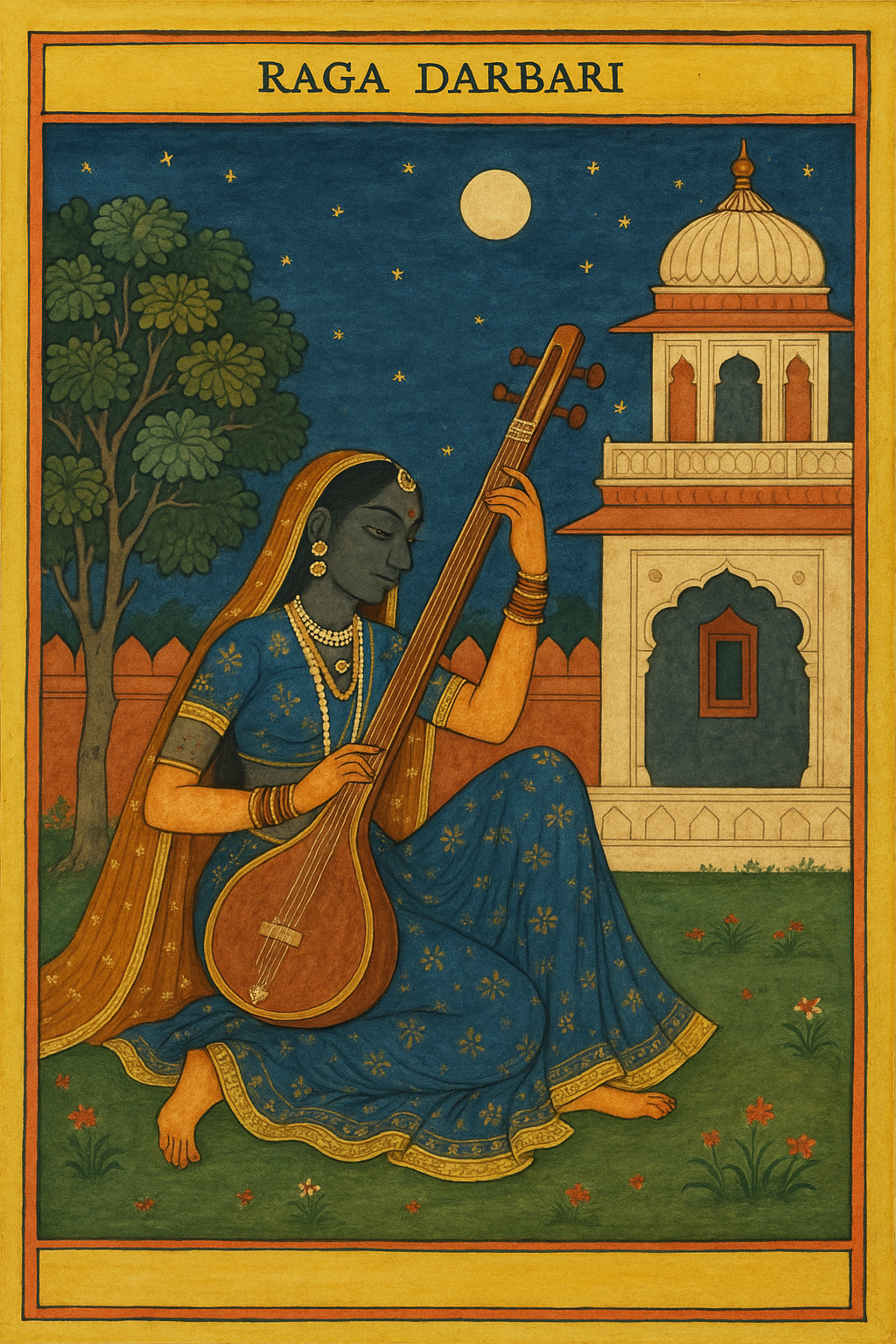Raga Darbari Kanada (commonly known as Darbari) is one of the most powerful, solemn, and emotionally charged ragas in the Hindustani classical tradition. Known for its deep, resonant, and introspective nature, Darbari evokes grandeur, gravity, and a sense of royal dignity. It is traditionally associated with late-night performances and has captivated listeners for centuries with its meditative beauty.

Origin and History
Raga Darbari Kanada belongs to the Kanada family of ragas, which are derived from folk traditions but were highly developed and stylised in the classical system. The term “Darbari” means “of the royal court.” It is believed that Miyan Tansen, the legendary musician in the court of Mughal Emperor Akbar, either created or significantly popularised this raga. Because of its solemnity and gravitas, it was considered fit for performance in royal courts.
It later became an essential part of Khayal, Dhrupad, Thumri, Tappa, and film music, as well as in Carnatic music (as Darbari Kanada).
Raga Characteristics
- Thaat (Parent Scale): Asavari
- Time of Performance: Late night (12 AM – 3 AM)
- Arohana (Ascent): S R (g) M P (d) n S’
- Avarohana (Descent): S’ n (d) P M (g) R S
Note: Darbari is noted for its heavy use of komal ga (♭3) and komal dha (♭6) with andolan (oscillation), which gives it its distinct flavor.
- Vadi (Most prominent note): Rishabh (Re)
- Samvadi (Second most prominent note): Pancham (Pa)
- Pakad (Signature Phrase): R (g) M P (d) n (d) P M (g) R
The melodic development is slow, often using meend (glides) and andolan (vibrations) on the komal swaras to create deep emotional effects. The movement is grave, with notes lingering and rolling, giving it a meditative quality.
Emotional Essence
Raga Darbari is not for the light-hearted. It evokes:
- Seriousness
- Majesty
- Devotion
- Sadness or pathos
- Philosophical introspection
It is often associated with royalty, spiritual yearning, and night-time solitude. The depth of Darbari allows the performer to display both musical skill and emotional nuance.
Use in Classical Music
🔷 Khayal and Dhrupad
- Darbari is a favourite in vilambit (slow tempo) khayal presentations.
- Dhrupad renditions in Darbari are majestic and meditative.
- It demands voice stability, control, and emotional maturity from the performer.
🔷 Instrumental Music
- Masters like Ustad Bismillah Khan (Shehnai), Ustad Amjad Ali Khan (Sarod), Pandit Ravi Shankar (Sitar), and Ustad Bismillah Khan have created masterful renditions of Darbari.
- It is particularly powerful on instruments with deep tones like sarod, bansuri, and sitar.
Use in Carnatic Music
Darbari Kanada has also found a place in Carnatic music, though with slightly different usage. While it retains its emotive quality, the ornamentation and grammar differ due to the structural differences between Hindustani and Carnatic systems.
Some famous Carnatic compositions include:
- “Rama Rama Gunaseema” – by Tyagaraja
- “Sagara Shayana Vibho” – by Muthuswami Dikshitar
Use in Film Music
Darbari has greatly influenced Indian film music. Its pathos and grandeur have inspired many songs in Hindi, Bengali, Tamil, Telugu, and other languages. Composers like Naushad, Madan Mohan, Ravi, Ilaiyaraaja, and A.R. Rahman have used its essence in numerous songs (see full list of Darbari-based film songs if needed).
Here is a curated list of popular film songs based on Raga Darbari Kanada:
🎵 Hindi Film Songs:
- “Dil Dhoondta Hai” – Mausam (1975)
- Singer: Bhupinder Singh, Lata Mangeshkar
- Music: Madan Mohan
- “Jhanak Jhanak Tori Baje Payaliya” – Mere Huzoor (1968)
- Singer: Manna Dey
- Music: Shankar-Jaikishan
- “Chalo Ek Baar Phir Se Ajnabi Ban Jayen” – Gumrah (1963)
- Singer: Mahendra Kapoor
- Music: Ravi
- “O Duniya Ke Rakhwale” – Baiju Bawra (1952)
- Singer: Mohammed Rafi
- Music: Naushad
- “Raat Bhar Ka Mehman Andhera” – Sone Ki Chidiya (1958)
- Singer: Talat Mahmood
- Music: O. P. Nayyar
- “Aaj Gawat Man Mero” – Baiju Bawra (1952)
- Singers: Ustad Amir Khan & Pandit D. V. Paluskar
- Music: Naushad
- “Dil Jo Na Keh Saka” – Bheegi Raat (1965)
- Singer: Mohammed Rafi
- Music: Roshan
🎶 Bengali Film / Modern Songs:
- “Jibone Ki Pabo Na” – Teen Bhubaner Pare (1969)
- Singer: Manna Dey
- Music: Sudhin Dasgupta
(Inspired by Darbari)
- “E Je Amon Kobita” – Modern Bengali song
- Singer: Srikanto Acharya
(Clearly evokes Darbari flavour)
- Singer: Srikanto Acharya
🎼 Tamil Film Songs:
- “Poo Maalai Vaangi Vandhaan” – Sindhu Bhairavi (1985)
- Singer: K. J. Yesudas
- Composer: Ilaiyaraaja
(Blend of Darbari with other ragas)
- “Aadal Kalaiye” – Sri Raghavendrar (1985)
- Singer: K. J. Yesudas
- Music: Ilaiyaraaja
(Strong Darbari influence)
🎧 Telugu Film Songs:
- “Jagadananda Karaka” – Tyagayya (1981)
- A composition by Tyagaraja used in the film; the raga Darbari Kanada is invoked in classical segments.
🕉️ Non-Film Classical/Popular Songs:
- “Bhavayami Gopalabalam” – though originally in Yaman Kalyani, some renditions introduce Darbari phrases.
- “Pibare Ramarasam” – While classically in Ahir Bhairav, film adaptations sometimes show a Darbari influence depending on arrangement.
Notable Performers
- Ustad Amir Khan – Known for profound Darbari khayal renditions.
- Pandit Bhimsen Joshi – Brought emotional power to Darbari in vocal music.
- Ustad Bismillah Khan – Transcendental Darbari on shehnai.
- Pandit Ravi Shankar – His sitar versions of Darbari are widely celebrated.
- Kumar Gandharva, Ustad Rashid Khan, Vidushi Kishori Amonkar, and Ustad Bade Ghulam Ali Khan also have significant Darbari renditions.
Raga Darbari is a jewel in the crown of Indian classical music. Rich in emotional depth and regal in tone, it stands as a testament to the expressive power of raga music. Whether presented in a serene Dhrupad, a flowing Khayal, or a soulful film song, Darbari continues to touch the deepest corners of the human heart.
